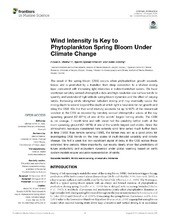| dc.contributor.author | Vikebø, Frode Bendiksen | |
| dc.contributor.author | Strand, Kjersti Opstad | |
| dc.contributor.author | Sundby, Svein | |
| dc.date.accessioned | 2019-12-11T12:57:59Z | |
| dc.date.available | 2019-12-11T12:57:59Z | |
| dc.date.issued | 2019-08-30 | |
| dc.Published | Vikebø FB, Strand KO, Sundby S. Wind Intensity Is Key to Phytoplankton Spring Bloom Under Climate Change. Frontiers in Marine Science. 2019;6:518 | eng |
| dc.identifier.issn | 2296-7745 | en_US |
| dc.identifier.uri | https://hdl.handle.net/1956/21089 | |
| dc.description.abstract | The onset of the spring bloom (OSB) occurs when phytoplankton growth exceeds losses and is promoted by a transition from deep convection to a shallow mixing layer concurrent with increasing light intensities in nutrient-enriched waters. We have combined remotely sensed chlorophyll-a data and high-resolution sea-surface winds to quantify and understand high-latitude spring-bloom dynamics and the effect of varying winds. Increasing winds strengthen turbulent mixing and may eventually cause the mixing depth to extend beyond the depth at which light is favorable for net growth and delay the OSB. We find that wind intensity accounts for up to 60% of the interannual variation in the OSB as revealed by remotely sensed chlorophyll-a values at the key spawning ground (62–63°N) of one of the worlds’ largest herring stocks. The OSB is, on average, 1 month later and with about half the variability farther north at the main spawning ground (67–68°N) of one of the world’s largest cod stocks. Since the atmospheric reanalysis considered here extends wind time series much further back in time (1958) than remote sensing (1998), the former may act as a good proxy for investigating OSB trends on the time scales of multi-decadal variability and climate change. We find a weak but non-significant signal of delay in the OSB across these extended time periods. More importantly, our results clearly show that predictions of future productivity and ecosystem dynamics under global warming based on earth system models require accurate representation of winds. | en_US |
| dc.language.iso | eng | eng |
| dc.publisher | Frontiers | en_US |
| dc.rights | Attribution CC BY | eng |
| dc.rights.uri | http://creativecommons.org/licenses/by/4.0 | eng |
| dc.subject | SeaWiFS | eng |
| dc.subject | MODIS | eng |
| dc.subject | remote sensing | eng |
| dc.subject | chlorophyll-a | eng |
| dc.subject | fish larvae | eng |
| dc.title | Wind Intensity Is Key to Phytoplankton Spring Bloom Under Climate Change | en_US |
| dc.type | Peer reviewed | |
| dc.type | Journal article | |
| dc.date.updated | 2019-10-04T11:28:01Z | |
| dc.description.version | publishedVersion | en_US |
| dc.rights.holder | Copyright 2019 The Author(s) | en_US |
| dc.identifier.doi | https://doi.org/10.3389/fmars.2019.00518 | |
| dc.identifier.cristin | 1733249 | |
| dc.source.journal | Frontiers in Marine Science | |
| dc.relation.project | Norges forskningsråd: 244262 | |
| dc.relation.project | Norges forskningsråd: 255487 | |

